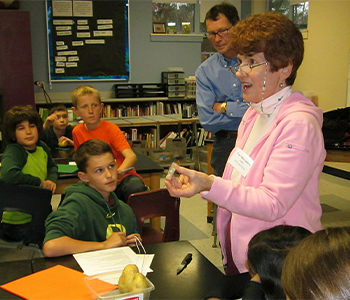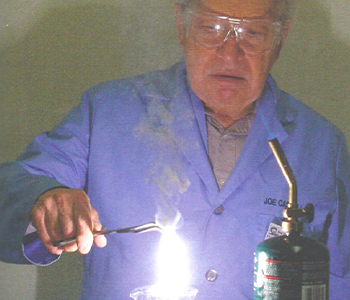Enhancing STEM Education & NGSS Implementation
By Joe Castellano and Hope Oliver
Over the past 30 years, there has been a decline in the number of U.S. college graduates seeking careers in science and engineering. Teaching Opportunities for Partners in Science (TOPS) of Santa Clara Valley is a volunteer program affiliated with the Institute of Electrical and Electronics Engineers (IEEE). TOPS is aimed at assisting science teachers in their classrooms to help stimulate greater interest in the sciences among students. TOPS volunteers are retired scientists and engineers who use their technical knowledge and extensive experience to support teachers implementing the Next Generation Science Standards (NGSS). As a middle school teacher, I enjoyed a 10-year collaboration with Dr. Joe Castellano in my classroom, and both of us value the experience as among the most meaningful in our lives. You can be a TOPS teacher also! For more details on TOPS’ activities, visit www.topsofscv.org.
Students are the ultimate benefactors of the TOPS program. They find role models in the mature, well-trained scientists and engineers who guide them in mastering scientific habits of mind and ways of thinking as well as science concepts and experimental skills. Real world phenomena became clearer to my students working alongside “Mr. C,” as Joe told stories that communicated his deep appreciation for relevance acquired over the course of a long STEM career. My middle school students told evaluators and parents that “Mr. C” inspired them to take more science courses in high school…and they did!


Teachers say their TOPS partners help them better prepare to teach NGSS by being a content resource and by modeling how scientists solve problems. Teachers also appreciate the extra pair of skilled hands to assist with activities.
I was competent at classroom management of an activity-based classroom, but as an early adopter of NGSS, I worried that my biology degree did not prepare me to teach NGSS physics and chemistry concepts well enough to prepare my middle school students for high school success. But I was inspired and grew more confident as I developed deeper content understanding through my collaboration with Joe, drawing on his real-world experiences and rigorously schooled mind.
The most important factor for success is a good working relationship between the TOPS volunteer and the teacher. Most TOPS volunteers spend one or two days per week in the classroom working with students doing experiments and demonstrations in collaboration with the teacher. Another day is spent preparing. Joe began by preparing and delivering slideshow presentations to introduce key questions and phenomena to be explored during that week’s investigation activity. He also did demonstrations. He helped set up experiments. It wasn't long before Joe asked to come on lab days to work with the students directly. Co-teaching began when students gravitated to Joe to re-explain or reteach. We progressed to developing investigations and later, entire NGSS units of study for the entire science department. The highlight of every year was the Builder’s Olympics, when Joe helped me coach each student through their choice of 3 engineering design challenges applying key scientific concepts.
For more details on TOPS’ activities, visit www.topsofscv.org.
- Examples of the support TOPS engineers and scientists can provide:
- Relate real world experiences and phenomena to the scientific concepts of NGSS.
- Design and build experimental set-ups that students conduct themselves.
- Present live demonstrations of chemical reactions, emission of light, electrical conductivity, magnetism, and other scientific principles.
- Present lectures using audio-visual aids (photos, videos, animations, drawings, etc.), typically using a personal computer and compact projector.
- Meet with individual students or small groups of two or three to answer student questions, explain, or re-teach fundamental skills and principles.
- Organize and assist teachers with after-school science clubs.
- Arrange field trips to local science museums, planetariums, and government or industrial research laboratories where students can see scientists at work.


Author Bio:
Hope & Joe enjoyed a productive 10-year collaboration through the TOPS program in Hope’s classroom at Bret Harte Middle School in the San Jose Unified School District.
Hope Oliver, hopeoliver@earthlink.net
– CASE/CSTA member since 1994, current CASE committee member and Mentor & Mentee Circle Facilitator; Middle school science teacher
Joe Castellano, drjcast@aol.com
– TOPS volunteer and retired chemist who performed basic scientific research, technology development, market research, and corporate management in a career spanning nearly 50 years. His early work involved the development of rocket fuels, surfactants, photochemistry and polymers. He was also a member of the team that developed the world’s first practical liquid crystal display (LCD) device. During his career, he authored or co-authored more than 60 scientific/technical papers as well as books, patents and government contract reports.





